Sophia’s Story: MAGEC Growing Rod Implantation to Treat Neuromuscular Scoliosis
Sophia’s Story: MAGEC Growing Rod Implantation to Treat Neuromuscular Scoliosis
Sophia was born at a hospital near her family’s home in South Jersey. An appointment at Children’s Hospital of Philadelphia (CHOP) when she was 4 months old to treat a brachial plexus birth injury led to the discovery that Sophia has a rare genetic disorder. Since then, she has seen CHOP specialists in audiology, orthopedics, neurology and numerous other specialties in an effort to improve her quality of life.

The brachial plexus is a complex network of nerves between the neck and shoulders that control muscle function in the upper limbs and torso. When Sophia was 4 months old, she had an occupational therapy (OT) appointment at CHOP to treat the condition. That appointment led to the discovery that a handful of other conditions were affecting her, including feeding difficulty and an inability to sit up on her own.
From there, “it was like quicksand,” says Sophia’s dad, Matt. “One thing after the other.”
A diagnostic workup by specialists in CHOP’s Division of Neurology revealed Sophia had a very rare genetic mutation in the CASK gene, a disorder that affects brain development. She has the severe form of the mutation called microcephaly. Her head circumference is smaller than normal and she is missing 75% of her cerebellum, which is important for coordination, balance and speech. Her parents were told she might not be able to do things like sit, walk, talk, or eat and drink on her own.
At an appointment with the Orthopedic Center, the family received more bad news. The genetic mutation was causing neuromuscular scoliosis. The condition impaired Sophia’s ability to control the muscles that support her spine. The curve in her spine was so severe that it was causing thoracic insufficiency syndrome, which affects normal breathing and lung growth.
“Everything was falling on us all at once,” says Sophia’s mom, Angela.
Noninvasive treatment of thoracic insufficiency syndrome
Sophia was referred to CHOP’s Wyss/Campbell Center for Thoracic Insufficiency Syndrome. After evaluating imaging of her spine, Center Director Patrick J. Cahill, MD, discussed the severity of the condition with Sophia’s parents. He suggested she be fitted for a Mehta cast immediately. Mehta casting is a noninvasive treatment for managing early onset scoliosis and correcting the curve in the spine. The cast was customized to Sophia’s body and spanned her armpits to her waist, with an opening in the front and a small opening in the back.
“It was overwhelming, and we knew it wasn’t a quick fix,” says Matt. “[Dr. Cahill] told us eventually she would need surgery to put rods in her back to stabilize her spine.”
Sophia had little to no trunk control. The body cast helped hold her upright so the organs in her chest weren’t compressed. But over the next two years, the curve in her spine grew progressively worse and she suffered chronic respiratory issues. Sophia was hospitalized twice, once with respiratory syncytial virus (RSV) and the other with pneumonia. Dr. Cahill wanted to delay an invasive procedure like spine surgery for as long as possible. But the time had come for a more permanent and effective treatment.
“The cast wasn’t solving the problem for the long term,” says Matt. “She was never going to be able to sit up on her own without surgery.”
MAGEC rod implantation has dramatic impact

Because of Sophia’s young age, Dr. Cahill recommended the MAGEC™ (MAGnetic Expansion Control) System. MAGEC growing rods are surgically implanted into the back. Unlike traditional growing rods, invasive surgery isn’t needed to expand MAGEC rods as Sophia grows. Instead, MAGEC rods are lengthened magnetically using an external remote control. Only a few facilities around the U.S. currently offer this cutting-edge treatment.
Sophia had the rods implanted when she was 5. The postsurgical recovery was hard, as Sophia is fully dependent on her parents and 24/7 nursing support. She can’t talk, eats through a G-tube, needs glasses and hearing aids, and uses a wheelchair. She also suffers from seizures. The surgery has had a tremendous impact on her health. She hasn’t had any respiratory issues since, sits up better, and is able to be transferred by her caregivers more easily.
“This has given her a better quality of life,” says Matt, who describes his daughter, now 6, as a happy, good-natured girl who loves Disney and music.